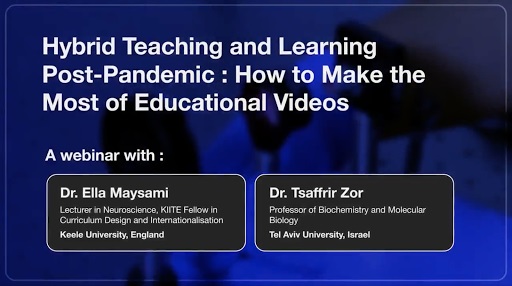In last week’s JoVE webinar, Dr. Ella Maysami - Lecturer in Neuroscience, KIITE Fellow in Curriculum Design and Internationalisation, Keele University, England and Dr. Tsaffrir Zor - Professor of Biochemistry & Molecular Biology, Tel Aviv University, Israel dived deep into their personal experiences and innovations while discussing 'Hybrid Teaching and Learning Post-Pandemic'.
While teaching at Higher Education Centres in the UK and international organizations Dr. Maysami pioneered the projects 'Blended Teaching and Learning in Laboratory Practicals’ and 'Final Year Projects' at Keele University. Dr. Maysami is a Fellow in Curriculum Design and Internationalization. Her experience aided the transition to fully remote instruction during the pandemic and put her in a position to help colleagues on campus. Dr. Zor has been serving as the chairman of the curriculum committee of the Life Sciences faculty. During the last four years, he conceptualized a cost-effective recording studio, enabling instructors to tape high-quality virtual lectures. Dr. Zor’s vision has been to help others from his experiences of using video in instruction and to keep students engaged in science courses.
Their unique experiences form a comprehensive guide for instructors looking to engage their students on or off-campus and ensure the longevity of instructional design efforts in the post-pandemic era. Below is a small selection of takeaways from their experience. Many more actionable suggestions and tips were discussed in the hour-long webinar, which you can view by requesting a free recording below.
Request a free webinar recording.
1.Technology-led instruction
Dr. Maysami suggests the assessment process be technology-led and further elaborates that, “We can make research educational videos much more interactive by adding quizzes, polls, and activities such as pair matching of two cohorts of the scientific content, Q&A sessions, [and] multiple-choice questions.”
She lists examples of the application of technology in higher education, such as How-to videos, interactive activities, assessment, and feedback. She goes on to emphasize the importance of students being able to visualize a day in the life of a research scientist, medic, engineer, or astrophysics scientist.
2. Providing short, well-segmented videos to keep students focused
Dr. Mayasami draws from her experience as a student, researcher, and lecturer to design blended teaching and learning strategies where pre-recorded educational videos are used in classrooms. She is also an advocate of short, well-segmented videos like the ones from JoVE. She says, “Instead of one-hour long videos that the students might have difficulties downloading or streaming, we broke it down to 20 minutes. This way the student will be able to watch it on the go or download it quicker, and have sufficient pause.” Dr. Zor also highlights the importance of short segmented videos in keeping students engaged. Being able to comprehend each step of the way helps students to be attentive throughout the class.
3. Remote lab sessions using videos of experiments have proven beneficial given the hazardous nature of some laboratory components
It’s safer and helps institutions save money and resources when a student can see lab experiments first-hand without the danger of being around harmful lab materials. Dr. Mayasami elaborates on how she was able to expose her students to experimental procedures that involved hazardous reagents like Xylene, which is flammable and can cause dizziness, irritations of the eye, skin, and can even be lethal when handled without proper precautions. The videos can demonstrate everything from the reagents & equipment used, the mandatory precautions, the individual steps in the procedure followed by the analyses of the results obtained.
4. Technical and high-quality resources without the huge investments
Technical and high-quality resources are critical to keeping students engaged within blended learning classrooms. Dr. Zor highlights the process of creating a MOOC video by Tel Aviv University’s online education platform. The production cost of the video is rightly labeled as expensive, however, he also suggests that as long as educators have access to zoom, good quality microphones, cameras, and a quiet environment, they don’t need to invest a large sum in the recording studio.
5. Use of videos to help enhance other critical skills to increase student engagement
In addition to the embedded videos in her curriculum, Dr. Mayasami has also experimented with streaming video blogs. Her ‘bite-sized’ blog series allows students to delve deep into specific neuroscience topics while keeping distractions at bay. She also uses video blogs to pass critical skills to her students like How to write an essay and What are the contents of peer-peer reviewing. Such skills can be hard to transfer in the absence of interpersonal interactions, but as always, video to the rescue! While these helpful blogs were enhanced by self-made videos when it came to the courseware topics like How drug discovery happens, she relied on JoVE videos to explain and demonstrate curriculum topics and methods.
To learn more about Dr. Ella Maysami and Dr. Tsaffrir Zor’s approach to using JoVE — and many other insightful takeaways from their experiences, you can request a recording of this session here.

